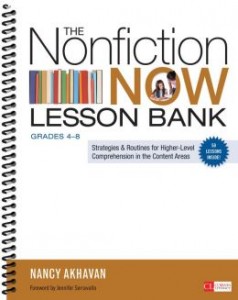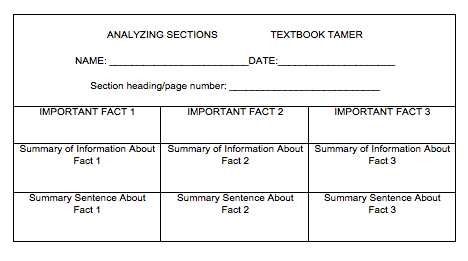The Nonfiction Guide You Need Right Now
The Nonfiction NOW Lesson Bank (Grades 4-8): Strategies and Routines for Higher-Level Comprehension in the Content Areas
By Nancy Akhavan
(Corwin Literacy, 2014 – Learn more)

By now, educators are aware that the Common Core State Standards place an emphasis on children reading informational texts.
According to the standards, by 2014, 50 percent of what fourth graders read and 70 percent of high school seniors’ reading material should be high quality non-fiction.
Now, consider the following: The average child in the United States spends roughly 4 hours and 29 minutes a day watching TV, 2 hours and 31 minutes listening to music, and 1 hour and 13 minutes playing video games. How much of their leisure time to do they spend reading nonfiction? Less than 4 minutes a day. (Rideout, Foehr, & Roberts, 2010)
As a veteran fourth grade teacher, I have witnessed the changes in literacy instruction. When I was offered the chance to review the book, The Nonfiction NOW Lesson Bank (Grades 4-8) by Nancy Akhavan, I was very excited.

While it is important to capitalize on this passion for factual learning, I also know that just wanting to read about a topic is not sufficient. Students need to be strategic readers who are able to (Ganske, 2010):
- Establish goals for reading
- Select reading strategies appropriate for the text they are reading
- Make connections between texts
- Infer
- Synthesize
- Visualize
- Monitor their reading to determine if they are comprehending or not
- Use fix-up strategies when understanding falters
- Question
- Have stamina and a can-do perseverance even with lengthy, complex texts
- Maintain a positive attitude toward reading
That’s a tall order for our readers and a difficult task for teachers. We want our students to be able to comprehend what they are reading, to go beyond the text in their thinking while not killing their love for reading. For many classrooms, especially those not equipped with high quality nonfiction books, this presents a challenge.
As I read the book, I felt as if Nancy Akhavan was the “guide at my side.” She reminded me of the importance of my role in the formation and direct instruction of literacy. She gives the teacher a chance to “take a deep breath and remind ourselves that as teachers we always have the power to adjust instruction so it works for our students – and the CCSS support this.”(p. 9)
A deep look into close reading
One of the areas that Akhavan addresses in depth is close reading—“a mindful, careful, meticulous look at a text, picture, or scene.” (Brummett, 2010). She gives the reader a comprehensive background of the goals of close reading, how to introduce the fundamentals of close reading, how to troubleshoot, and the selection of appropriate texts. What I found especially significant is how she addressees the shift in focus from “What does the teacher want me to think about the text?” to “What do I take from and think about the text?”

Nancy Akhavan
Ms. Akhavan’s spiral-bound book is definitely a lesson bank – a bank that keeps multiplying your knowledge and interest. She begins with fundamental lessons for introducing close reading, provides strategies for deeper reading of nonfiction, introduces the Daily Duo sequenced for weekly lesson and unit planning, and offers 50 engaging lessons on teaching nonfiction, including five centered on close reading. What other bank can offer you this?
Fully developed lessons
She structures the chapters so that each section can stand alone or be used as needed. Each section has a research based introduction, with guidelines to be used as a reference, and tips for teachers. Many of the lessons have reproducible handouts (which are also available online, with a code from the book). All of the lessons are appropriate and adaptable for grades 4-8 and with students of all abilities.
The author acknowledges the fact that our students will be reading more than trade books and high interest articles. Hence, the “Textbook Tamer” chapter. She provides the reader with graphic organizers, such as the one below, that will help students connect, map, remember and build higher level comprehension skills as they are reading.
The Nonfiction NOW Lesson Bank (Grades 4-8) is an essential resource for everyone interested in effectively teaching higher level comprehension skills. In my opinion, it’s really a must-have for any teacher’s collection of “Top Ten Professional Books.” It’s that good. In fact, on a scale of one to ten, this book is definitely an “eleven.”
Classroom applications, student examples, ready to use texts, and easily adaptable lesson plans make this a book you’ll turn to again and again.
Linda Biondi is a fourth grade teacher at Pond Road Middle School in Robbinsville, NJ, and a long-time Morning Meeting practitioner. She’s also the recipient of several educational grants, a Teacher Consultant with the National Writing Project and a participant on the NJ Department of Education Teacher Advisory Panel. She recently shared her thoughts about the Common Core at the NJ SDE website.



































